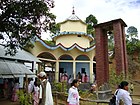Meitei architecture: Difference between revisions
bare url |
m Dating maintenance tags: {{Bareurls}} |
||
| Line 1: | Line 1: | ||
{{Short description|Architecture of the Meitei people}} |
{{Short description|Architecture of the Meitei people}} |
||
{{bareurls}} |
{{bareurls|date=July 2020}} |
||
[[File:Temple_at_Kangla.jpg|thumb|300px|The ancient Meitei temple of Lord [[Pakhangba]] restored in 2007 inside the [[Kangla Palace]], [[Manipur]]]] |
[[File:Temple_at_Kangla.jpg|thumb|300px|The ancient Meitei temple of Lord [[Pakhangba]] restored in 2007 inside the [[Kangla Palace]], [[Manipur]]]] |
||
Revision as of 18:19, 28 July 2020

Meitei architecture or Manipuri architecture is the architecture produced by the Meitei speaking people, whose culture flourished in the Kangleipak kingdom and its neighbouring kingdoms from the middle of the fifteenth century BC. The Meitei architecture is best known for its temples (Laishang, Kiyong,Thellon), found scattered in the Kangleipak (present day Manipur). Other architectural forms that are still in existence are the grand gates (Hojang), Traditional houses (Yumjao), Public houses (Sanglen), Official buildings (Loishang), etc.[1][2]
Influence
Due to the arrival of Hinduism in the kingdom of Kangleipak (present day Manipur), the form of architecture was greatly influenced during the 16-17th century AD. Hundreds of Vaishnava temples were built in the kingdom with a mixed architectural design of both the traditional Meitei architecture and Mainland Indian architecture.[3]
Styles
The temples and other buildings built in Meitei architecture is easily distinguished by the Holy Chirong (horns), attached on the top of the roof. Some of the significant examples are easily seen in the Hiyangthang Lairembi Temple and Sanamahi Kiyong Temple.[4] There are styles of engraving animal figures it the walls of the buildings, especially the figures of bulls, Buffalo, etc. are mainly found.[5]
Gallery
-
A Vaishnava temple at Imphal
-
A Hindu temple at Kakching Khunou, Manipur
-
A Hindu temple at Imphal
-
The Western Gate of Kangla Palace, Imphal
-
The ruins of old temple inside the Kangla Palace, Imphal
-
Old ruins at Kangla Palace
-
Bihu Loukon, aerial view
-
Grand gate of Shrine of Lord Khamlangba, with a holy horn in the top
-
A Hindu temple in Meitei style at Kakching
See also
References
- ^ http://www.e-pao.net/epSubPageExtractor.asp?src=education.Scientific_Papers.Scientific_Principles_of_Ancient_Manipuri_Yumjao_House_and_its_Courtyard_By_Khwairakpam_Gajananda
- ^ http://e-pao.net/epSubPageExtractor.asp?src=℅20manipur.Arts_and_Culture.Meitei_Yumjao_The_Endangered_Art
- ^ https://www.sahapedia.org/the-vaishnava-temples-of-manipur-historical-study
- ^ https://imphaleast.nic.in/tourist-place/sanamahi_kiyong/Sanamahi Lainingkol
- ^ https://www.webindia123.com/MANIPUR/ART/index.html








